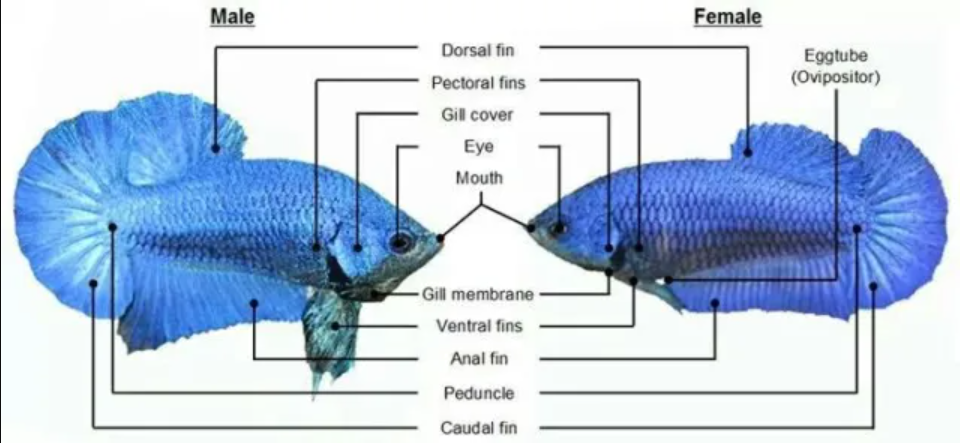Betta splendens, commonly known as Siamese fighting fish, are one of the most popular aquarium fish in the world. Their vibrant colors and unique personalities make them a favorite among fish enthusiasts. However, to truly appreciate and care for these beautiful creatures, it’s crucial to understand the fundamental differences between male and female Betta splendens. In this comprehensive guide, we will delve deep into the distinctions that set these two sexes apart.
1. Physical Characteristics
Male Betta Splendens
Male Betta splendens are renowned for their striking appearance. They have long, flowing fins that can be quite elaborate. These fins are often adorned with vibrant colors and intricate patterns. The males are also larger than their female counterparts, typically reaching a size of 2.5 to 3 inches.
Female Betta Splendens
In contrast, female Betta splendens have shorter fins and a more streamlined body. While they lack the flamboyant finnage of the males, they compensate with their sleek and elegant appearance. Female Bettas usually grow to be around 2 to 2.5 inches long.

2. Coloration
Male Betta Splendens
Male Bettas are known for their breathtaking coloration. They come in a wide array of hues, including vibrant reds, blues, greens, and even metallic shades. The intensity of their colors can change depending on their mood and surroundings. When agitated or during courtship displays, male Bettas often display their most vibrant colors.
Female Betta Splendens
Female Betta splendens, while still attractive, typically have more subdued colors. They tend to be shades of pale blue, green, or brown. Female Bettas have a unique beauty all their own, with subtle variations in color and pattern that can be appreciated by observant enthusiasts.
3. Fins and Tail
Male Betta Splendens
The fins and tail of male Bettas are their crowning glory. They have long dorsal fins, caudal fins (tails), and anal fins that are often elaborately adorned. These fins are used not only for swimming but also for display and intimidation during territorial disputes.
Female Betta Splendens
Female Bettas, while lacking the extravagant fins of their male counterparts, have more practical fins and tails. Their fins are shorter and less ornate, which allows for greater maneuverability. This streamlined physique is advantageous for their natural behaviors and activities.
4. Behavior
Male Betta Splendens
One of the most well-known characteristics of male Betta splendens is their aggressiveness. They are territorial and will fiercely defend their space, especially from other males. This aggression is why they are commonly referred to as “fighting fish.” When two male Bettas are placed in the same tank, they may engage in aggressive displays, which can sometimes lead to physical combat.
Female Betta Splendens
Female Bettas, on the other hand, are generally less aggressive. They can coexist peacefully with other female Bettas and community fish species in a well-maintained aquarium. However, it’s essential to monitor their behavior, as some females can also exhibit territorial tendencies, especially when breeding.
5. Reproductive Differences
Male Betta Splendens
Male Bettas are responsible for building bubble nests when they are ready to breed. These nests are made of bubbles they create at the water’s surface and serve as protection for their offspring. Males are also responsible for courting females by displaying their vibrant colors and engaging in intricate dance-like behaviors.
Female Betta Splendens
Female Bettas do not create bubble nests. Instead, they lay eggs, which the male fertilizes. After spawning, it’s crucial to separate the male from the female, as he may become aggressive towards her or eat the eggs. The female plays no role in caring for the eggs or the fry.
6. Lifespan and Care
Male Betta Splendens
Both male and female Betta splendens have a similar lifespan of approximately 2 to 4 years, depending on their care and environment. To ensure their longevity, it’s essential to provide them with a well-maintained aquarium, appropriate water conditions, and a balanced diet. Regular water changes and monitoring of water parameters are essential for their well-being.
Conclusion
In summary, understanding the fundamental differences between male and female Betta splendens is crucial for providing them with the appropriate care and creating a harmonious aquarium environment. While males are known for their stunning colors and elaborate fins, females possess their unique beauty and contribute to the overall dynamics of a Betta community tank.
To ensure the well-being of these captivating fish, it’s essential to consider their distinct characteristics, behaviors, and requirements. By doing so, you can create a thriving aquatic ecosystem that showcases the splendor of both male and female Betta splendens.



